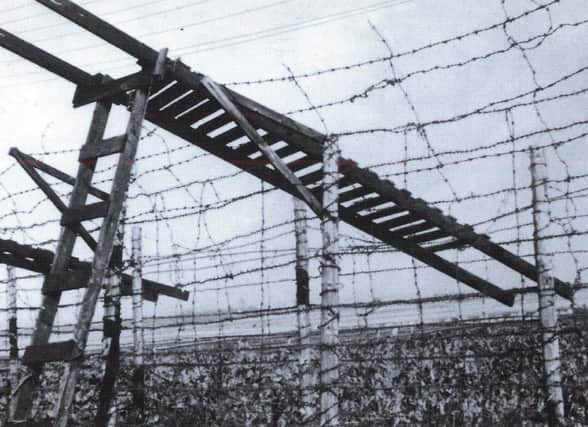New book reveals even greater WWII ‘Great Escape’


The audacious breakout saw dozens of allied PoWs scale the wire at a camp deep in Nazi Germany using four huge ladders they had made and disguised as bookshelves.
Thirty-two got out and the legendary pilot Douglas Bader – who was a prisoner in the camp, Oflag VI-B near Warburg – described the event as the most daring escape of the war.
Advertisement
Hide AdAdvertisement
Hide AdHowever, it was overshadowed by the famous Great Escape which used a tunnel and was immortalised in a Hollywood film starring Steve McQueen and Richard Attenborough.
But the new book describes the incredible breakout two years earlier and pays tribute to the unsung heroes behind it.
They were led by Major Tom Stallard, a charismatic 37-year-old from Bath who was one of the most determined escape artists in captivity.
He first planned to get 250 men out but in the end settled on 40 and, after repeated failures with tunnels, decided to go over the wire.
A young Scottish lieutenant, Jock Hamilton-Baillie, 23, came up with the idea of the folding ladders to scale twin 12ft high perimeter fences 6ft apart.
Maj Stallard launched Operation Olympian – so-called because it was an international effort involving men from all over the Commonwealth – which took five months to plan.
The ladders were made of two 11ft-long sections, each with seven rungs, which would open and form a right-angled bridge up and across the fence.
The wood was plundered from a hut the Germans had wrecked after finding yet another tunnel.
Advertisement
Hide AdAdvertisement
Hide AdThe first ladder was made in the camp’s music room where the prisoners had relatively free rein and the sawing and hammering could be hidden by the sounds of instruments.
The two sections were stood against the wall and disguised as new shelving units and filled with sheet music and other literature.
CONNECT WITH THE SCOTSMAN
• Subscribe to our daily newsletter (requires registration) and get the latest news, sport and business headlines delivered to your inbox every morning
They even fooled the camp’s chief security officer Hauptmann Rademacher, who inspected them and praised them as being well made.
In the meantime, the prisoners had discovered how to short-circuit the perimeter floodlights thanks to an electrical fault deliberately left by forced labourers who built the camp.
As the ladders were built, a forging department dubbed “Thomas Cook” produced the documents the escapers would need.
They were led by RAF Flt Lt Gilbert “Tim” Walenn, an ace forger who was the basis for Donald Pleasance’s character in The Great Escape film.
Flt Lt Walenn took part in the real Great Escape from Stalag Luft III in 1944 and was among 50 escapees executed in cold blood on Hitler’s orders.
Advertisement
Hide AdAdvertisement
Hide AdZero hour for the escape was set at 21:30 on 30 August 1942 and the 40 escapees gathered in two huts near the perimeter.
Each man carried 12lbs of food to last him between 18 and 21 days, plus a washing kit, tinned cigarettes, basic medical kit, spare socks and underwear.
Maps were made on very fine tissue paper and compasses were smuggled into the camp in Red Cross parcels by MI9, the specialist “escape” arm of military intelligence in London.
The lights were knocked out and a short distance away two homemade grappling hooks left hidden by the wire were pulled by unseen hands to distract the nearest sentry 50 yards away.
Two white painted ladders had been left leaning against the fence, adding to the bluff, and a stream of fake orders were shouted in the air by two German-speaking British officers.
In the music room, other prisoners were gleefully playing instruments as loudly as possible to add to the general confusion.
The diversions worked perfectly as the four ten-man teams darted from the huts carrying their ladders “like firemen”, and hit the fence.
Four men quickly erected them and locked the “bridge” section in place, and the teams poured over the wire.
Advertisement
Hide AdAdvertisement
Hide AdUnluckily, ladder 4 collapsed after just two men got over but the other three worked like clockwork and in just 40 seconds, a total of 32 men were free.
Author Mark Felton, a military historian, said: “The escape itself was one of the first mass escapes and to my mind the most daring of the war.”
• Zero Night, The Untold Story of World War Two’s Most Daring Great Escape, by Mark Felton is published by Icon Books.
SCOTSMAN TABLET AND IPHONE APPS